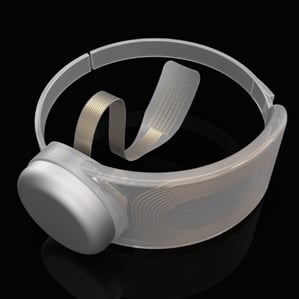Bionic Eye Implant Approved for U.S. Patients
A prosthetic device that can restore some sight to the blind has been approved by the U.S. Food and Drug Administration. The company that makes the device, Second Sight, based in Sylmar, California, can now market the retinal prosthetic to patients with advanced retinitis pigmentosa, a degenerative eye disease that can cause blindness. This is the first approved treatment for the disease in the United States.

“This enables people who are completely blind to see enough to improve their mobility,” says Mark Humayun, a professor of biomedical engineering at the University of Southern California in Los Angeles who has been developing the device for the past 25 years. “It allows people to make out the sidewalk and stay on it without twisting an ankle, see unexpected obstacles like parked cars, make out a table, see someone coming through a doorway,” he says. Some patients can make out large letters, but the main function of the implant is to give patients enough sight to restore mobility.
The device, called the Argus II, has three main parts: a glasses-mounted video camera; a portable computer; and a chip implanted near the retina. The video camera sends image data to the computer, which is worn on a belt. The processor converts the image data into electrical signals that are beamed to a chip implanted near the retina. The signals are then sent to an array of 60 electrodes that stimulate the retinal cells. These electrodes essentially do the work of the light-sensing cells that have degenerated. So far, the system can’t help patients make out different colors, but it can provide them with enough visual sensation to sense the outlines of things nearby.

The Argus II was approved for use in Europe in March 2011 (see “A Bionic Eye Comes to Market”) and has been implanted in 30 patients in a U.S. clinical trial that started in 2007. The company has not announced its pricing structure in the U.S., but the devices retail for $100,000 in Europe, a price based on the expectation that the implant will last 10 years. Humayun says surgeons around the country, including those in Los Angeles, San Francisco, Philadelphia, and Baltimore, have been trained in the surgery to implant the device.
An estimated 100,000 people in the United States suffer from retinitis pigmentosa, a disease that slowly kills off the light-sensing cells in the retina, starting with the rod cells responsible for periphery and night vision, and eventually the cone cells, which provide central vision. The result is a gradual tunneling in of the vision, leading eventually to complete blindness. Humayun estimates that there are about 2,000 Americans in this late phase of the disease that would benefit from the device.
“This is a really exciting day—this is the first approved treatment for retinitis pigmentosa,” says Jacque Duncan, professor of clinical oncology at the University of California, San Francisco. There are some drugs in clinical trials, and there is some evidence that vitamin A slows the disease’s progress, but until now there has been no way to restore lost vision to the blind. “It’s very exciting to reach this point.”
Existing devices like pacemakers and cochlear implants also use electrodes to interface with the body. But none are as complicated as the retinal prosthetic, says Humayun. Cochlear implants use up to about 20 electrodes; the Argus II uses three times as many, all of which have to be wired up in a compact, biocompatible case that won’t overheat, and can tolerate the frequent movements of the eye. “This is the most complicated medical implant there is, in terms of the number of electrodes,” says Humayun.
Humayun says future software developments will expand the capabilities of the Argus II. The company is developing software that will enable the device to stimulate patients to see color by providing electrical signals at different frequencies.
Keep Reading
Most Popular
Large language models can do jaw-dropping things. But nobody knows exactly why.
And that's a problem. Figuring it out is one of the biggest scientific puzzles of our time and a crucial step towards controlling more powerful future models.
The problem with plug-in hybrids? Their drivers.
Plug-in hybrids are often sold as a transition to EVs, but new data from Europe shows we’re still underestimating the emissions they produce.
Google DeepMind’s new generative model makes Super Mario–like games from scratch
Genie learns how to control games by watching hours and hours of video. It could help train next-gen robots too.
How scientists traced a mysterious covid case back to six toilets
When wastewater surveillance turns into a hunt for a single infected individual, the ethics get tricky.
Stay connected
Get the latest updates from
MIT Technology Review
Discover special offers, top stories, upcoming events, and more.